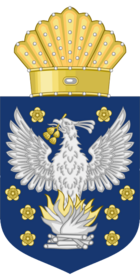Zhen dynasty
Zhen dynasty 秦 진 | |||||||||||||||
|---|---|---|---|---|---|---|---|---|---|---|---|---|---|---|---|
| 330 BC–514 AD | |||||||||||||||
|
Flag | |||||||||||||||
 Map of the Zhen dynasty's domain at its greatest extent, around 200 AD. | |||||||||||||||
| Capital | Jinyang | ||||||||||||||
| Common languages | Zhenian | ||||||||||||||
| Religion | Zhenian Wuism (official religion since 231 AD), Heavenly worship, Taoism, Buddhism, Confucianism | ||||||||||||||
| Government | Absolute monarchy, Empire | ||||||||||||||
| Emperor | |||||||||||||||
• 330 - 278 BC | Taizo Emperor | ||||||||||||||
• 511 - 514 | Sangjo Emperor | ||||||||||||||
| Historical era | Antiquity, Ancient era | ||||||||||||||
• Coronation of Emperor Taizo | May 8 330 BC | ||||||||||||||
• Conquest of the South | 155 BC - 107 AD | ||||||||||||||
• Zhen-Balakhaat Wars | 205 - 331 | ||||||||||||||
• Fall of Jinyang | December 5 514 AD | ||||||||||||||
| Population | |||||||||||||||
• 100 BC | 20,000,000 | ||||||||||||||
• 250 AD | 45,000,000 | ||||||||||||||
| Currency | Zhenian Coin, Zhenian Cash | ||||||||||||||
| |||||||||||||||
Part of a series on the |
|---|
| History of Zhenia |
 |
| Timeline |
The Zhen dynasty (Zhenian: 秦/진, pronounced Jin), also known as the Zhen Empire, was an imperial dynasty originating from modern-day eastern Zhenia, particularly the Danguk Peninsula region, and ruled most of the Zhenian subcontinent from 330 BC to 514 AD. Its rule was preceded by the long age of division throughout Zhenia known as the Age of War and Rebellion and succeeded by the Hundred States Era. Spanning over eight centuries of continuous unified rule, the Zhen dynasty is widely regarded as the first of the five golden ages in Zhenian history - the other three being the Han, Zhu and Shindan dynasties and the First Zhenian Republic. The Zhen dynasty is characterized by an era of the consolidation of a centralized, unitary government under Zhenian emperors and territorial holdings that extended well beyond the domains of modern-day Zhenia.

